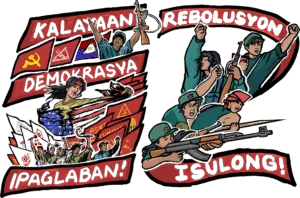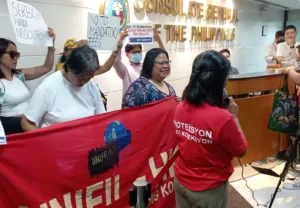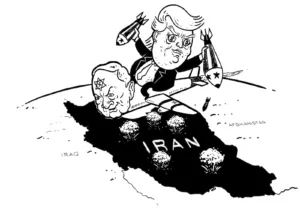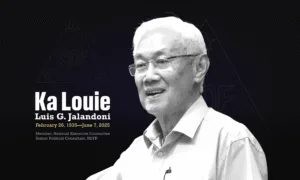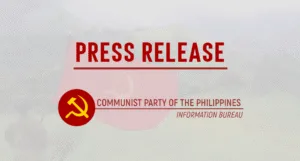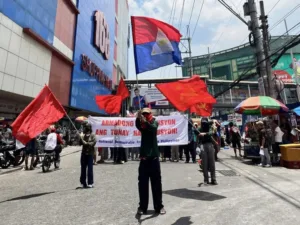Press Release | November 7, 2017
[Bisaya»]
Having experience colonization and modern-day slavery in its fields and factories, the peoples of the Philippines are currently aspiring for national liberation and genuine democracy against their colonizers and exploiters. They are looking up and learning from the revolutions of several nations, including the North American revolutions, to enlighten them on how to struggle and to win.
It is an opportune time to celebrate the Great October Socialist Revolution because the Filipino people could take up a thing or two about the Soviet Russian experience during the era of Tsarism and the First World War.
Just like the Filipinos, the Russian peoples consisting of various nationalities have also aspired genuine liberation from the yoke of the so-called “militarist-feudal” imperialism in Russia during the time of their leader, Vladimir Ulyanov, also known as Lenin to his comrades-in-arms. Their country was plagued by imperialist oppression and plunder even after decades of the Stolypin reforms similar to the defunct land reform program of the Aquino regime in the Philippines in the 1980s.
The feudal-militarist ruler in Russia exploits their peasantry and proletariat while they collude with the British, French, Belgian and German financial aristocrats. The 1905 revolution and then the parliamentary struggles inside and outside the State Duma have harnessed the potential of millions of workers and peasants throughout the whole of Russia into building similar to that of the Philippine’s people power and they have called these as Soviet power.
Soviets are revolutionary organs of power consisting of peasants, workers and soldiers of the revolutionary army. They were organized by the Bolshevik Party of the Russian proletariat. The revolutionary army mainly came from the Tsarist army who turned away their rifles from the people and their foreign enemies and trained them instead to their aggressor, the Tsar himself.
Soviets gained ground in pressing their need for peace, land and liberty. Most of the small nationalities surrounding Russia heeded these slogans of Lenin’s Bolshevik Party and worked hard for these demands. With the Tsarist expensive wars of aggression against Japan and Germany in a tug-of-war for colonies, the people of Russia could not bear the brunt anymore. Exploitation increased on taxation, on industrial production for the war and on requisition of farm outputs.
The 1917 February and October revolution triumphantly broke the chain of Tsarism and imperialist aggression. Lenin led them all the way to the victory of the Soviets and to the solidarity of the Eastern European peoples in hailing the first socialist Soviet republic in the whole world. Since then, the socialist system has engendered the acceleration of the existence and downfall of the imperialist system.
The Philippines had their share of the Soviet spark that ignited the darkening of our colonial history. The first Filipino communists, led by the unionist Crisanto Evangelista, secretly entered Russia through China in 1928 in order to learn the Russian Soviet experience. They founded the Communist Party of the Philippines (CPP) on November 7, 1930, concelebrating the 13th anniversary of the October Revolution in Russia. They founded the Hukbo ng Bayan Laban sa Hapon (HUKBALAHAP) on March 29, 1942 and lead the guerilla warfare against Japan in an anti-fascist and pro-Allied united front during World War II. Throughout Luzon, these guerillas have implemented land confiscation from pro-Japanese landlords and traitors.
Enlightened by China-style guerilla warfare against the British and American imperialism and the local military-bureaucratic warlordism in China, the young Filipino communists led by Jose Maria Sison rebuilt on December 26, 1968 the PKP under the theoretical guide of Mao Tse-tung Thought.
Mao Tse-tung built their Soviet-style revolutionary government in Shanxi, a mountainous northern China loess plain, after their legendary Long March in anticipation for the intensified Japanese invasion in the whole of China in 1936. Enthusiastic support from their peasantry, the Chinese workers, middle class and city-dwellers came to these base areas, especially in Bao’an and Yenan, which culminated to an almost nationwide, self-reliant, anti-fascist counter-offensive against Japan in 1945. Yenan then became a catchword for revolutionaries in China.
The Philippines can and should aspire to put to action China or Russia’s soviet power experience in order to win in the Philippine revolution. The seeds have been sown since 1968 and the fruits have dispersed their seeds throughout the archipelago. Lenin’s notion of the transmission belts and Mao’s “three magic weapons” of the Party, the army and the mass base has been put to test for the past 48 years despite a temporary setback in the 1980s to the early 1990s.
The raw materials for building Filipino people’s revolutionary united front and Soviet power have been there from the start. With the impending intensification of the neoliberal policies of the Philippine state and the imposition of US dominance in Southeast Asia since its Asian-pivot policy since 2011, the Filipino people are again called to arms. The world has witnessed two world wars and are expecting a third that may spark in the Asia-Pacific region given that China has empowered itself militarily and economically as an imperialist power for the past four decades of policy regime changes after Mao Tse-tung’s time.
Having witnessed the bankrupt imperialist policies and reforms due to recurring convulsions of the world economic system, peoples and countries who had a taste of Soviet and democratic power in the past century preferred socialism as an economic system which needs to resurge. This new century is dawning wherein imperialism may encounter a crisis that is unprecedented. It may be terrible, but it’s fine.
The Filipino proletariat is in the right place today for launching anti-imperialist struggles. Together with the peasantry and the middle class, they can exploit the advantage of being able to break away from exploitation, national oppression and foreign domination in the economic, political, cultural and military fields should imperialist war break out once more. They have the CPP as the vanguard in liberating the nation first from US imperialism. They can foster solidarity outwardly with the peoples and democracies of the world against world war and against Asiatic and Pacific aggression of the imperialists. Their migrant workers also have a critical role in popularizing and gaining worldwide support for the Philippine revolution.
Internally, they can launch socio-economic development for workers and peasants, with local allies and international support, despite enforced evacuations due to disasters, militarism in Mindanao and national fascism. Areas discreetly claimed as revolutionary organs of power in the countryside are taking advantage of land reform and production campaigns, legal and extra-legal options, community initiatives for development and new methods of social networking combining internet technologies and word-of-mouth reportage.
Regarding their people’s army, the New People’s Army imbibes the spirit of whole-heartedly serving the people and the revolution. They utilize all available forms of propaganda to reach out to broad workers and peasant population. They are the most effective machinery of the Party in increasing and strengthening the mass base and in gaining both local and international support for the war. They educate the masses with the current trends in politics and various forms of open and underground organizations for them to perform heavier and heavier tasks. They can hit even the most fascist target wherever and whenever they can, with the people vigorously assisting them in launching tactical offensives.
These seeds, which may be termed Filipino Soviets, are still in their germination stage. But the aggravating crisis conditions could surely empower them for swift victory. All power shall soon be theirs.
Hail the Great October Socialist Revolution!
Long live the Communist Party of the Philippines!
Death to imperialism!
Long live proletarian internationalism!
Ka. Norcen Mangubat
Spokesperson
CPP – North Central Mindanao Region
Pamahayag sa Midya | Nobyembre 7, 2017
Dakung Posibilidad sa Pagbuhi-balik sa Diwang Sobyet sa Rusya dinhi sa Pilipinas
 Sa pagsinati sa kolonyalisasyon ug modernong pagpangulipon sa ilahang mga luna ug pabrika, ang katawhan sa Pilipinas sa kasamtangan nagtinguha alang sa nasudnong kalingkawasan ug tinuod nga demokrasya batok sa mga kolonyalista ug madaug-daugon. Taas ang ilahang panglantaw ug nagakat-on gikan sa mga rebolusyon sa lain-laing nasud, lakip na ang rebolusyong Amerikano, aron mahigmata sila kung unsaon makigbisog ug modaug.
Sa pagsinati sa kolonyalisasyon ug modernong pagpangulipon sa ilahang mga luna ug pabrika, ang katawhan sa Pilipinas sa kasamtangan nagtinguha alang sa nasudnong kalingkawasan ug tinuod nga demokrasya batok sa mga kolonyalista ug madaug-daugon. Taas ang ilahang panglantaw ug nagakat-on gikan sa mga rebolusyon sa lain-laing nasud, lakip na ang rebolusyong Amerikano, aron mahigmata sila kung unsaon makigbisog ug modaug.
Usa kini ka kahigayonan aron i-selebrar ang Bantugang Sosyalistang Rebolusyong Oktubre tungod kay makakuha ang katawhang Pilipino og pipila ka mga kasinatian sa Rusong Sobyet panahon sa Tsarismo ug sa Unang Gubat Pangkalibutan.
Susama sa katawhang Pilipino, nagtinguha usab ang mga katawhan sa Rusya, gikan sa lain-laing nasyunalidad, alang sa tinuod nga kagawasan gikan sa gapos sa ginatawag nga “militarista-pyudal” nga imperyalismo sa Rusya panahon sa ilang lider nga si Vladimir Ulyanov, nga nabantog sa pangalang Lenin ngadto sa iyahang mga kauban sa pakigbisog. Nag-antus ang ilahang nasud sa imperyalistang pagpahimulos ug pagpangawkaw human sa pipila ka dekadang mga repormang Stolypin nga susama sa namatay’ng reporma sa yuta sa rehimeng Aquino sa Pilipinas niadtong 1980.
Gipahimuslan sa pyudal-militarista nga mga pangulo sa Rusya ang ilang mga mag-uuma ug proletaryado samtang nakigkunsabo sila sa mga aristokrasya sa pinansyang British, French, Belgian ug German. Gisangkapan sa rebolusyong 1905 ug sa parlyamentaryong pakigbisog sa gawas ug sulod sa State Duma ang potensyal sa minilyon ka mga mamumuo ug mag-uuma sa tibuok Rusya ngadto sa pagtukod og susama sa people power sa Pilipinas, ug gitawag nila kining gahum sa Sobyet.
Rebolusyonaryong organo sa gahum ang mga Sobyet nga gilangkuban sa mga mag-uuma, mamumuo ug kasundalohan sa rebolusyonaryong hukbo. Gi-organisa sila sa Bolshevik Party sa proletaryong Ruso. Ang mga rebolusyonaryong hukbo naggikan nag-una sa Tsarist nga hukbo nga niwahing sa ilang mga armas gikan sa pagpunting sa katawhan ug sa ilang mga langyaw’ng kaaway ngadto sa gipunting sa ilang manunulong, lakip mismo sa Tsar.
Nakaginansya ang mga Sobyet og luna sa pagduso sa ilang panginahanglan sa kalinaw, yuta ug kagawasan. Kadaghanan sa mga gagmay’ng nasyunalidad nga nagpalibot sa Rusya nagpasiugda niining mga slogan sa Lenin’s Bolshevik Party ug mahago nga milihok alang niini nga mga demanda. Sa gastusong gyerang agresyon batok sa Japan ug Germany sa lumbaay alang sa mga kolonya, dili na maantus sa katawhan sa Rusya ang palas-anon. Nagkagrabe ang pagpahimulos sa pagpamuhis, sa produksyong industriyal alang sa gyera ug sa demanda alang sa abot sa uma.
Ang rebolusyong Pebrero ug Oktubre sa 1917 malampusong nakabugto sa kadena sa Tsarismo ug imperyalistang agresyon. Gipangulohan sila ni Lenin ngadto sa hingpit nga kadaugan sa mga Sobyet ug ngadto sa panaghiusa sa mga katawhan sa Eastern Europe sa pag-abiba sa unang sosyalistang republikang Sobyet sa tibuok kalibutan. Sukad niadto, nahimugso sa sosyalistang sistema ang pagpapaspas sa pagtumaw ug pagkahimugso sa imperyalistang sistema.
Adunay kabahinan ang Pilipinas sa Sobyet nga kiblat nga nagpadilaab sa pagdagtum sa atong kolonyal nga kasaysayan. Ang unang mga komunistang Pilipino, nga gipangulohan sa unyonistang si Crisanto Evangelista, sekretong misulod sa Rusya, pinaagi sa paglusot sa Tsina, niadtong 1928 aron makakat-on og kasinatian sa Rusong Sobyet. Gitukod nila ang Partido Komunista ng Pilipinas (PKP) niadtong Nobyembre 7, 1930, alang sa pagsaulog usab sa ika-13 nga kasumaran sa Rebolusyong Oktubre sa Rusya. Gitukod nila ang Hukbong Bayan Laban sa mga Hapon (HUKBALAHAP) niadtong Marso 29, 1942 ug gipangulohan ang gerilyang pakiggubat batok sa Hapon sa usa ka kontra-pasista ug pabor-sa-alyansa nga nagkahiusang prente panahon sa Ikaduhang Gubat Pangkalibutan. Sa tibuok Luzon, gi-implementar niini nga mga gerilya ang pagkumpiska sa kayutaan gikan sa mga maki-Hapones nga mga agalong yutaan ug mga traydor ug libreng giapud-apod sa mga mag-uuma.
Sa dan-ag sa estilong-Tsino nga gerilyang pakiggubat batok sa imperyalistang British ug Amerikano ug sa lokal nga warlordismong militar-burukrata sa China, subling gitukod sa mga kabatan-unang komunistang Pilipino, nga gipangulohan ni Jose Maria Sison, niadtong Disyembre 26, 1968 ang PKP ilalom sa teoretikal nga giya sa Panghuna-hunang Mao Tse-tung.
Gitukod nilang Mao Tse-tung ang ilahang istilong-Sobyet nga rebolusyonaryong gobyerno sa Shanxi, usa ka bukirong bahin sa amihanang China, human sa ilahang makasaysayanong Long March alang sa pag-antisipar sa nagkakusog nga pagpanulong sa Hapones sa tibuok Tsina niadtong 1936. Niabot niining mga baseng erya ang madasigong suporta gikan sa mga mag-uuma, sa mga mamumuong Tsino, ug sa mga hatungang hut-ong ug mga lumulupyo, ilabina sa Bao’an ug Yenan, nga mipungkay sa usa ka halos nasudnon, nagkinaugalingon, kontra-pasistang kontra-opensiba batok sa Hapon niadtong 1945. Nahimo na dayong islogan ang Yenan alang sa mga rebolusyonaryo sa China.
Ang Pilipinas mahimo ug kinahanglang magtinguha nga ikinabuhi ang kasinatian sa sobyet nga gahum sa China o Rusya aron mapadaug ang rebolusyong Pilipino. Natanom na ang mga binhi niadto pang 1968 ug nakahatag na og mga bunga sa tibuok nasud. Nasulayan ang hukbo ug ang baseng masa sa panghunahuna ni Lenin sa mga transmission belt ug ni Mao sa “tulo ka gamhanang hinagiban” sa Partido, sa nilabay’ng 48 ka tuig taliwala sa temporaryong pag-atras niadtong 1980 ngadto sa sayong bahin sa 1990.
Ang mga hilawng materyales alang sa pagtukod sa rebolusyonaryong nagkahiusang prente sa katawhang Pilipino ug sa Sobyet nga gahum anaa na sukad pa sa sinugdanan. Sa mapanumpuong nagkakusog nga palisiyang neoliberal sa estado sa Pilipinas ug sa pagpahamtang sa pagdominar sa US sa Southeast Asia sukad sa palisiyang Asian-pivot niadtong 2011, subling nanawagan sa katawhang Pilipino nga mag-armas. Nasaksihan sa kalibutan ang duha ka pangkalibutang gubat ug nagdahom sa ikatulo nga posibleng moulbo sa Asia-Pacific Region sa kahimtang nga napalig-on sa China ang kaugalingon sa pangmilitar ug pang-ekonomiya isip imperyalistang gahum sa nilabay’ng upat ka dekadang kabag-ohan sa palisiya sa rehimen human sa kapanahunan ni Mao Tse-tung.
Sa pagsaksi sa pagkabangkarote sa mga imperyalistang palisiya ug reporma tungod sa subling kaguliyang sa pangkalibutang sistema sa ekonomiya, mas gipaboran sa mga katawhan ug mga nasud, nga nakasinati sa gahum sa Sobyet ug demokrasya sa nilabay’ng siglo, ang sosyalismo isip ekonomikanhong sistema nga kinahanglang subling ibangon. Nagbanag-banag na kini niini nga siglo, kung asa posibleng sagubangon sa imperyalismo ang wala sukad nahitabong krisis. Makalilisang kini, apan maanindot.
Anaa ang katawhang Pilipino sa hustong kahigayunan karon alang sa paglunsad og mga kontra-imperyalistang pakigbisog. Kauban ang mga mag-uuma ug ang hatungang hut-ong, pwede nilang pahimuslan ang bentaha sa katakus nga gub-on ang pagpangdaug-daog, nasudnong pagpihig ug langyaw’ng dominasyon sa natad sa ekonomiya, pulitika, kultura ug militar kung moulbo na usab ang imperyalistang gubat. Anaa silay PKP isip dugukan sa pagpalingkawas una sa nasud gikan sa imperyalismong US. Mahimo nilang mopalambo og panaghiusa sa mga katawhan ug mga demokrasya sa kalibutan batok sa gubat pangkalibutan ug batok sa Asiatic ug Pacific nga pagpangatake sa mga imperyalista. Anaa usa’y kritikal nga papel ang mga migranteng mamumuo sa pag-popularisa ug pagtigom sa tibuok-kalibutang suporta alang sa rebolusyong Pilipino.
Sa pangsulod, pwede nilang ilunsad ang sosyo-ekonomikanhong kalamboan alang sa mga mamumuo ug mag-uuma, kauban ang mga lokal nga higala ug internasyunal nga suporta, taliwala sa pugos nga pagpamakwit tungod sa kalamidad, militarisasyon sa Mindanao ug nasudnong pasismo. Gipatuman sa mga erya sa kabanikanhan sa rebolusyonaryong organo sa pulitikanhong gahum ang pagpatuman sa tinuod nga reporma sa yuta ug kampanya sa produksyon, ligal o extra-ligal man, mga community initiative alang sa kalamboan ug bag-ong pamaagi sa social networking pinaagi sa pagkumbina sa teknolohiya sa internet ug pagtaho.
Mahitungod sa ilang hukbo sa katawhan, nahuptan sa Bagong Hukbong Bayan ang diwa sa tibuok-kasing-kasing nga pag-alagad sa katawhan ug sa rebolusyon. Gipahimuslan nila ang tanang pwedeng magamit nga porma sa propaganda aron kab-uton ang lapad nga populasyon sa mga mamumuo ug mag-uuma. Sila ang pinaka-epektibong makinarya sa Partido sa pagpa-usbaw ug pagpakusog sa baseng masa ug sa pagtigom og lokal ug internasyunal nga suporta alang sa gubat. Gi-edukar nila ang mga masa sa kasamtangang dagan sa pulitika ug lain-laing porma sa abli ug tago nga mga organisasyon aron mapapelan nila ang mga nagkabug-at nga mga tahas. Maigo nila bisan ang pinaka-pasistang target bisan asa ug bisan kanus-a nila gusto, kauban ang mainantusong pag-abag sa katawhan kanila sa paglunsad og mga taktikal nga opensiba.
Kini nga mga binhi, nga pwedeng tawagong Pilipinong Sobyet, anaa pa sa ilahang ang-ang sa pagbuswak. Apan ang nagkagrabeng krisis nga mga kahimtang seguradong mopagahum kanila alang sa paspas nga kadaugan. Ang tanang gahum, sa dili madugay, mahimo nang ma-ilaha.
Mabuhi ang Bantugang Sosyalistang Rebolusyong Oktubre!
Mabuhi ang Partido Komunista ng Pilipinas!
Kamatayon sa Imperyalismo!
Mabuhi ang proletaryong internasyunalismo!
Ka. Norcen Mangubat
Tigpamaba
CPP – North Central Mindanao Region
